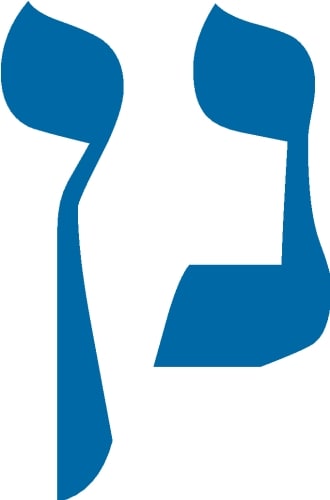 The ark of the covenant and its impact on the people of Israel is clearly so important ,as we see in the fact that the verses dealing with it are bracketed in the Torah by two upside down Hebrew letter “Nuns ( pronounced as Noons).
The ark of the covenant and its impact on the people of Israel is clearly so important ,as we see in the fact that the verses dealing with it are bracketed in the Torah by two upside down Hebrew letter “Nuns ( pronounced as Noons).
The verses read :
“When the Ark would journey, Moshe said ‘Arise, HaShem, and let Your enemies be scattered and let those who hate You flee from before You.’ And when it rested, he would say, return O HaShem among the myriads and thousands of Israel.'” [Bamdibar 10:35-36].”
The tractate Shabbat ( 115b) explains that this section is bracketed with the two upside down “nuns” to indicate that this segment should have been written in the previous portions of Bamidbar or Naso where the formations and the travels of the camp were initially described. The talmud explains that the section was put here as a type of reprieve between the “first account of punishment” and the “second account of punishment” .
Clearly the second difficult period is found in the following verses that declare “And the people were like those who seek pretexts of evil in the ears of HaShem” (Bamidbar 11:1).Yet we must determine what was the first “account of punishment” that seemingly occurred before our section. The sages points to the verse “And they journey from the Mountain of Hashem…” (Bamidbar 10:33). The classic commentator Tosfot explains that “In journeying away from Mt. Sinai, they acted like children running away from the school house.” This was after they stood at mount Sinai and declared as one people Naasseh Venishma, we will do and we will understand”, both words beginning with the letter ” Nun” The Me’am Lo’ez written by Rabbi Yaakov Culi explained that after their hasty departure those Nuns became inverted.
This was a people that were still a young nation. They were still a people suffering from the psychological damage of being a slave people. They were a growing nation still unsure of their first steps into freedom and into their journey through the wilderness.
Perhaps the placement of this section was not simply a reprieve from the narrative of failure and resulting punishment but was actually a message of hope and direction.
Rabbi Menachem Mendel Yosef Zaks describes how the verses describing the travels of the tabernacle actually describe the travels and journey of the Jewish people throughout the ages.
“When the Ark would journey, Moshe said’ Arise, Hashem, and let Your enemies be scattered and let those who hate You flee from before You.[Bamdibar 10:35].”
When the Jewish people would wander from place to place in exile,Moshe asks that G-d protect them from the enemies that will swoop over them like vultures.
Then the verse continues ” And when it rested, he would say, ‘Return O Hashem among the myriads and thousands of Israel.'” [Bamdibar 10:36].”
We are meant to understand that when the people will merit to rest, they also may fall into complacency. In the midst of that complacency they may slip even further into assimilation and spiritual anonymity. It is regarding this that Moshe asks “Return O Hashem among the myriads and thousands of Israel” The word Shuva that is used seems to be implying the thought that though the people may lose direction in their imagined tranquility, Moshe is asking HaShem that he spur in them the spirit of Teshuvah
Rav Yonatan Eibeshetz, author of the “Tiferet Yonatan” suggests even further, that the placement of the inverted Nuns was a sign of hope and G-d’s faithfulness. He points to the verse in the song of Songs (2:9.) “My Beloved resembles a gazelle”. When a deer or gazelle is running away from something it often turns it head backwards..The letter Nun resembles that running Gazelle.
The message for this people is that regardless of what emotional or spiritual state they are in, G-d is still keeping eye contact with them. Regardless of the fact that He may be entering a phase of hiding His face” He is reminding them that “the eyes of HaShem your G-d are on it( the land ) from the beginning of the year and until the end of the year” (Deut. 11:12).
The letter Nun is also the first letter of faithfulness, Neemanut. In the midst of the perils of exile and in the midst of the dangers of the complacency of “resting” , that is all we can depend on . As we read in psalm 92:3 “To declare Your lovingkindness in the morning, and Your faithfulness in the night seasons”

Geez, that’s unbeilevbale. Kudos and such.